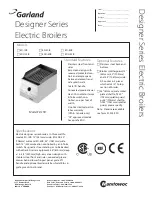
3
Regulations
SU300.5 | SU400.5 – 6 720 819 326 (2019/12)
37
2.6
Product description
3
Regulations
Observe the following directives and standards:
• Local regulations
•
EnEG
(in Germany)
•
EnEV
(in Germany)
Installation of, and equipment for, heating and water heating systems:
•
DIN
and
EN
standards
–
DIN 4753-1
– Water heaters ...; requirements, identification,
equipment and testing
–
DIN 4753-3
– Water heaters ...; corrosion protection on the
water side through enamel coating; requirements and testing
(product standard)
–
DIN 4753-6
– Water heating systems ...; cathodic corrosion
protection for enamelled steel cylinders; requirements and
testing (product standard)
–
DIN 4753-8
– Water heaters ..., part 8: Thermal insulation of
DHW cylinders up to 1000 l nominal capacity – requirements and
testing (product standard)
–
DIN EN 12897
– Water supply - regulation for... DHW cylinders
(product standard)
–
DIN 1988
– Technical rules for potable water installations
–
DIN EN 1717
– Protection of potable water against
contamination...
–
DIN EN 806
– Technical rules for potable water installations
–
DIN 4708
– Central DHW heating systems
•
DVGW
– Code of practice W 551 – Potable water heating systems and
pipework; technical measures to inhibit the growth of legionella
bacteria in new systems;...
– Code of Practice W 553 – Sizing DHW circulation systems... .
4
Transport
▶ When handling, prevent DHW cylinders from falling.
▶ Move packed DHW cylinder with a sack trolley and strap (
-or-
▶ Move unpacked DHW cylinder with a transport net; during handling,
protect connections against possible damage.
5
Installation
The DHW cylinder is delivered as a fully assembled unit.
▶ Check that the DHW cylinder is complete and undamaged.
5.1
Siting
5.1.1
Installation site requirements
▶ Site the DHW cylinder on a plinth if there is a risk that water may
collect at the installation site.
▶ Site the DHW cylinder in dry internal areas that are free from the risk
of frost.
▶ Observe the minimum room height (
Table 4, page 36) and
minimum wall clearances inside the installation room
(
Fig. 6, page 54).
5.1.2
Positioning the DHW cylinder
▶ Stand the DHW cylinder upright and level it (
page 54).
▶ Remove protective caps.
▶ Apply Teflon tape or Teflon string (
5.2
Hydraulic connection
5.2.1
Connecting the DHW cylinder on the water side
System example with all recommended valves and stopcocks
(
Fig. 10, page 55).
▶ Use installation material that is heat-resistant to 160 °C (320 °F).
▶ Never use open vented expansion vessels.
▶ Use metal connection fittings in DHW heating systems with plastic
lines.
▶ Size the drain line in accordance with the connection.
▶ To facilitate blow-down, never install bends in the drain line.
▶ Keep primary lines as short as possible and insulate them.
▶ If using a non-return valve in the cold water supply: Install a safety
valve between the non-return valve and the cold water inlet.
▶ Install a pressure reducer if the static system pressure is in excess of
5 bar.
▶ Seal all superfluous connections.
Pos.
Description
1
DHW outlet
2
DHW circulation connection
3
Cylinder flow
4
Sensor well for temperature sensor, heat source
5
Cylinder return
6
Cold water inlet
7
Indirect coil for reheating by the boiler, enamelled smooth tube
8
Inspection apertures for service and cleaning at the front
9
Cylinder, enamelled steel
10
Magnesium anode
11
PS casing lid
12
Casing, painted sheet metal with rigid polyurethane foam
insulation, 50 mm
Table 6 Product description (
Fig. 3, page 53 and Fig. 10, page 55)
NOTICE:
System damage through inadequate load
bearing capacity of the supporting surface or unsuitable
substrate.
▶ Ensure that the installation area is level and offers
sufficient load-bearing capacity.
WARNING:
Risk of fire through soldering and welding!
▶ Take appropriate safety measures when soldering
and welding as the thermal insulation is flammable.
For example, cover up the thermal insulation.
▶ Check cylinder casing after completion for perfect
condition.
WARNING:
Risk to health through contaminated water!
Work carried out without due care for cleanliness
contaminates the potable water.
▶ Install and equip the DHW cylinder hygienically in
accordance with national standards and guidelines.
















































